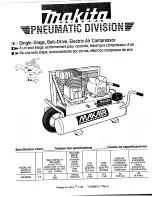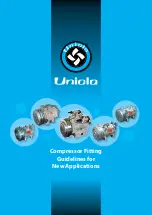
Installation
Danfoss PSH compressors can tolerate liquid
refrigerant up to a certain extend without major
problems. However, excessive liquid refrigerant in
the compressor is always unfavourable for service
life. Besides, the installation cooling capacity may
be reduced because of the evaporation taking
place in the compressor and/or the suction line
instead of the evaporator. System design must be
such that the amount of liquid refrigerant in the
compressor is limited.
Refrigerant charge limit
Insulation resistance on motor pins and
thermistor connections must be higher than 1
megohm when measured with a 500 volt direct
current megohm tester. Never perform insulation
resistance test on control board power leads.
Each compressor motor is tested at the factory
with a high potential voltage (hi-pot) that
exceeds the UL requirement both in potential
and in duration. Leakage current is less than
0.5 mA.
It is not recommended to repeat high voltage test
(hi-pot) on motor. If this test must be carried out
anyway, it is mandatory to disconnect the control
board to prevent any damages or destruction.
PSH scroll compressors are configured with
the pump assembly at the top of the shell,
and the motor below. As a result, the motor
can be partially immersed in refrigerant and
oil. The presence of refrigerant around the
motor windings will result in lower resistance
values to ground and higher leakage current
readings. Such readings do not indicate a faulty
compressor.
In testing insulation resistance, Danfoss
recommends that the system be first operated
briefly to distribute refrigerant throughout the
system.
Following this brief operation, retest the
compressor for insulation resistance or current
leakage.
Never reset a breaker or replace a fuse without
first checking for a ground fault (a short circuit to
ground). Be alert for sounds of arcing inside the
compressor.
Model
Refrigerant charge limit
in the compressor (kg)
PSH019
5.9
PSH023-026-030-034-039
7.9
Insulation resistance and
dielectric strength
The system must be monitored after initial start-
up for a minimum of 60 minutes to ensure proper
operating characteristics such as:
• Proper metering device operation and
desired superheat readings
• Suction and discharge pressure are within
acceptable levels
• Correct oil level in compressor sump
indicating proper oil return
• Low foaming in sight glass and compressor
sump temperature 10K above saturation
temperature to show that there is no
refrigerant migration taking place
• Acceptable cycling rate of compressors,
including duration of run times
• Current draw of individual compressors
within acceptable values (max operating
current)
• No abnormal vibrations and noise.
Commissioning
In installations with good oil return and line
runs up to 20 m, no additional oil is required. If
installation lines exceed 20 m, additional oil may
be needed. 1 or 2% of the total system refrigerant
charge (in weight) can be used to roughly define
the required oil top-up quantity but in any case
the oil charge has to be adjusted based on the oil
level in the compressor sight glass.
When the compressor is running under stabilized
conditions the oil level must be visible in the
sight glass.
The presence of foam filling in the sight glass
indicates large concentration of refrigerant in the
oil and / or presence of liquid returning to the
compressor.
The oil level can also be checked a few minutes
after the compressor stops. When the compressor
is off, the level in the sight glass can be
influenced by the presence of refrigerant in the
oil.
Always use original Danfoss POE oil 160SZ from
new cans.
Top-up the oil while the compressor is idle. Use
the schrader connector or any other accessible
connector on the compressor suction line and
a suitable pump. See News bulletin “Lubricants
filling in instructions for Danfoss Commercial
Compressors”.
Oil level checking and
top-up
35
FRCC.PC.022.A4.02
Application Guidelines










































